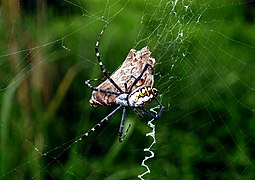Junonia atlites
| Junonia atlites | ||||||||||||
|---|---|---|---|---|---|---|---|---|---|---|---|---|

Junonia atlites |
||||||||||||
| Systematics | ||||||||||||
|
||||||||||||
| Scientific name | ||||||||||||
| Junonia atlites | ||||||||||||
| ( Linnaeus , 1763) |
Junonia atlites is a butterfly ( butterflies )found in Asiafrom the noble butterfly family(Nymphalidae).
description
butterfly
The wingspan of the moth is 55 to 65 millimeters. There is no sexual dimorphism . The basic color of the wing tops of both sexes is ash gray to gray-brown. In front of the wing edge, two dark brown wavy lines extend over both pairs of wings. In the submarginal region there is a series of bright black-rimmed eye spots, some of which are half orange and half black-brown. On the light gray underside of the wing, the eyespots on the front shimmer only faintly. A very thin black transverse line runs through the disk region of the underside of the hind wings, which is weakened and continues on the forewings.
egg
The eggs are laid individually on the leaves or shoots of the host plants. They are greenish in color, spherical, flattened at the tip and have a diameter of 0.6 to 0.7 millimeters. The surface is covered with many longitudinal ribs. After about three days, the caterpillar hatches from the egg.
Caterpillar
The young caterpillar first eats the egg shell. It is yellowish orange in color. The surface of the body is covered with small warts and thin dark hairs. The head capsule is black. In the further course of development, the color of the caterpillar changes from glassy green to brownish to black. When fully grown, it shows many black branched thorns and thin short white hairs as well as an orange-colored side stripe on the body surface. It then reaches a length of 45 millimeters.
Doll
The pupa is designed as a falling pupa and hangs on branches or petioles. It is gray-brown in color and has a series of dorsolateral pairs of short and pointed processes on each segment. After about six days of development, the pupa turns dark brown and some drawing elements of the moths hatching the next day already shine through the pupa’s skin.
Similar species
The moths of Junonia atlites are unmistakable due to the very distinctive wing pattern .
distribution and habitat
The nominate form Junonia atlites atlites occurs in India , Nepal , Thailand , Malaysia , Singapore as well as on Sumatra and Borneo . On Sulawesi and Banggai it is represented by the subspecies Junonia atlites acera . The species prefers to colonize forest clearings, river banks, roadsides and the fringes of agricultural land. The height distribution extends from 200 to 1000 meters.
Way of life
The moths fly in several generations throughout the year, mainly in April and October. They like to suckle on the ground at damp places in the earth to absorb liquids and minerals. They also often visit flowers to take in nectar. However, they are sometimes preyed on by crab spiders (Thomisidae), which lurk on the flowers for food. They are also sometimes victims of orb-web spiders (Araneoidea) of the genus Argiope . The caterpillars feed polyphagously on the leaves of many different plants, for example acanthus family (Acanthaceae), foxtail family (Amaranthaceae), Linderniaceae or rice ( Oryza ).
Butterfly suckling on zinnia blossom
Individual evidence
- ^ India Diversity Portal
- ↑ a b c stages of development
- ↑ Markku Savela: Junonia Hübner, [1819] - distribution. In: Lepidoptera and some other life forms. Retrieved May 16, 2019 .
- ^ Butterflies of Thailand, Malaysia & Borneo
- ↑ flight times
Web links
- Lepiforum e. V. - Junonia atlites in the Lepiforum
- ifoundbutterflies - Gray Pansy at Butterflies of India
- insecta.pro - taxonomy





